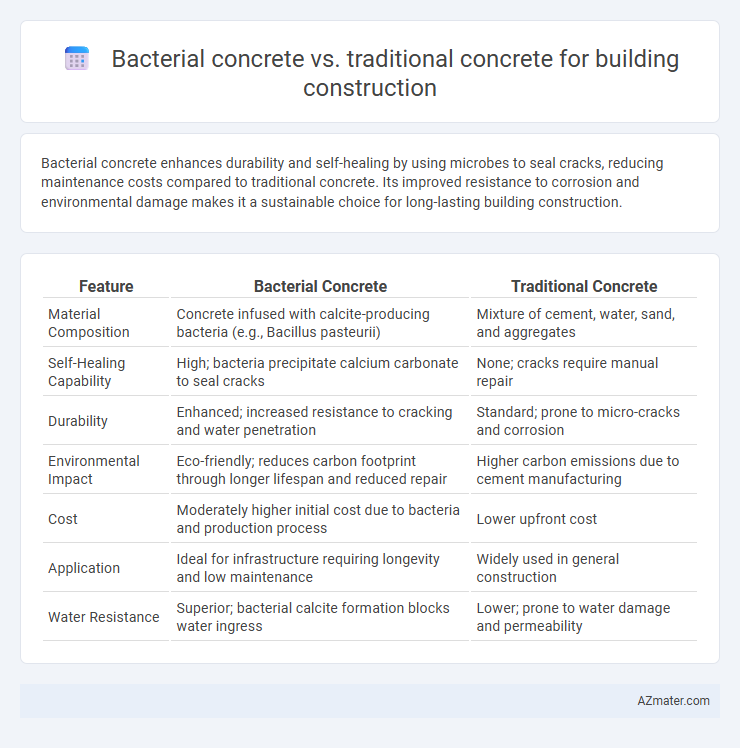Bacterial concrete enhances durability and self-healing by using microbes to seal cracks, reducing maintenance costs compared to traditional concrete. Its improved resistance to corrosion and environmental damage makes it a sustainable choice for long-lasting building construction.
Table of Comparison
| Feature | Bacterial Concrete | Traditional Concrete |
|---|---|---|
| Material Composition | Concrete infused with calcite-producing bacteria (e.g., Bacillus pasteurii) | Mixture of cement, water, sand, and aggregates |
| Self-Healing Capability | High; bacteria precipitate calcium carbonate to seal cracks | None; cracks require manual repair |
| Durability | Enhanced; increased resistance to cracking and water penetration | Standard; prone to micro-cracks and corrosion |
| Environmental Impact | Eco-friendly; reduces carbon footprint through longer lifespan and reduced repair | Higher carbon emissions due to cement manufacturing |
| Cost | Moderately higher initial cost due to bacteria and production process | Lower upfront cost |
| Application | Ideal for infrastructure requiring longevity and low maintenance | Widely used in general construction |
| Water Resistance | Superior; bacterial calcite formation blocks water ingress | Lower; prone to water damage and permeability |
Introduction to Bacterial Concrete and Traditional Concrete
Bacterial concrete incorporates specific strains of bacteria that precipitate calcium carbonate, enhancing self-healing properties and reducing crack formation, which improves durability and longevity in building construction. Traditional concrete relies on a mixture of cement, aggregates, and water, providing structural strength but often requiring maintenance due to cracking and environmental degradation over time. The integration of bacterial technology addresses common issues in traditional concrete by promoting automatic repair mechanisms, reducing repair costs and environmental impact.
How Bacterial Concrete Works
Bacterial concrete enhances traditional concrete by incorporating specific bacteria, such as Bacillus pasteurii, that produce calcium carbonate when triggered by moisture and oxygen, sealing cracks autonomously. This bio-mineralization strengthens the concrete matrix and significantly reduces permeability and corrosion of steel reinforcement. The self-healing property of bacterial concrete improves the durability and lifespan of structures compared to conventional concrete, which relies solely on passive crack control and maintenance.
Composition of Traditional Concrete
Traditional concrete consists primarily of cement, aggregates (sand, gravel, or crushed stone), and water, forming a rigid composite material through a hydration process. The cement acts as a binder, chemically reacting with water to create a hardened matrix that encapsulates the aggregates and imparts strength. This conventional composition provides durability and compressive strength but is prone to cracking and requires maintenance over time.
Key Differences Between Bacterial and Traditional Concrete
Bacterial concrete incorporates specialized bacteria that precipitate calcium carbonate to heal cracks autonomously, enhancing durability and reducing maintenance costs compared to traditional concrete, which lacks self-healing properties. Traditional concrete relies primarily on mechanical strength and chemical composition, while bacterial concrete actively improves structural longevity by sealing microcracks, thereby increasing resistance to water ingress and corrosion. The use of bacteria in concrete also offers environmental benefits by extending the lifespan of structures and minimizing the need for frequent repairs.
Durability and Longevity Comparison
Bacterial concrete significantly enhances durability and longevity compared to traditional concrete by utilizing microbial-induced calcite precipitation to self-heal cracks and reduce porosity, thereby preventing water ingress and corrosion. Studies show bacterial concrete can extend the lifespan of structures by up to 50% due to its superior resistance against environmental degradation and chemical attacks. Traditional concrete, while structurally strong, often suffers from microcracking and permeability issues that accelerate deterioration under harsh conditions.
Environmental Impact and Sustainability
Bacterial concrete incorporates microorganisms that precipitate calcium carbonate, enhancing crack healing and extending structural lifespan, reducing the need for frequent repairs and associated material waste typical of traditional concrete. Traditional concrete production accounts for approximately 8% of global CO2 emissions due to cement manufacturing, whereas bacterial concrete can lower the environmental footprint by improving durability and reducing cement content. The sustainability of bacterial concrete lies in its self-healing properties, which contribute to resource efficiency and reduced greenhouse gas emissions over the building lifecycle compared to conventional concrete solutions.
Cost Analysis: Bacterial vs Traditional Concrete
Bacterial concrete offers long-term cost benefits by reducing maintenance and repair expenses due to its self-healing properties that seal cracks autonomously. Traditional concrete has lower initial costs but often incurs higher lifecycle costs related to frequent repairs and structural degradation over time. Economic analysis shows bacterial concrete's upfront investment is justified by its durability, extending the service life of structures and decreasing overall lifecycle expenditures.
Applications in Modern Building Construction
Bacterial concrete enhances durability by self-healing cracks, significantly reducing maintenance costs in modern building construction compared to traditional concrete, which lacks this capability. Its application in infrastructure such as bridges, tunnels, and high-rise buildings improves longevity and resistance to environmental damage, extending structural life cycles. The eco-friendly properties and increased structural integrity of bacterial concrete make it a preferred choice for sustainable and resilient construction projects.
Challenges and Limitations of Bacterial Concrete
Bacterial concrete faces challenges such as high initial costs due to the cultivation and incorporation of bacteria, which can limit its widespread adoption in building construction. The long-term durability and performance of bacterial concrete under various environmental conditions remain uncertain, creating hesitation among builders and engineers. Additionally, the complexity of maintaining optimal bacterial activity within the concrete matrix poses limitations compared to the more predictable behavior of traditional concrete.
Future Prospects in Construction Industry
Bacterial concrete, enhanced with self-healing bacteria such as Bacillus subtilis, offers significant future prospects for the construction industry by increasing durability and reducing maintenance costs compared to traditional concrete. Its ability to autonomously repair micro-cracks improves structural longevity and sustainability, aligning with green building trends and reducing carbon footprint. Advancements in bio-concrete technology promise to revolutionize infrastructure resilience, making it a promising alternative in large-scale urban development and disaster-resistant construction.

Infographic: Bacterial concrete vs Traditional concrete for Building construction
 azmater.com
azmater.com